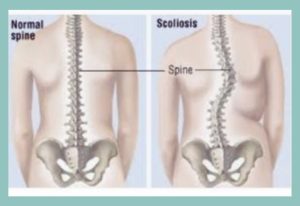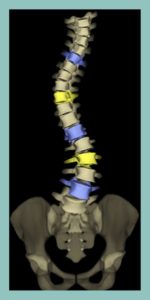How to Tell if Your Child Has Scoliosis
Scoliosis is a spine irregularity that causes the spine to curve in a “C” or “S” shape. It’s estimated that scoliosis affects 2-3% of the population or an estimated 7 million people in the United States. Adolescent Idiopathic Scoliosis (AIS) often makes its appearance around ages 10-18, most often being diagnosed in young girls.
Scoliosis is progressive in nature, which means that with time the spine can continue to curve and rotate. Researchers have not been able to find one specific cause for scoliosis. We do know that early detection is important when treating AIS and can mean the difference between surgery and no surgery. Since the spine tends to curve and rotate during times when a child grows, it is important to stabilize the spine with scoliosis specific physical therapy and/or a brace during these growth spurts.
With a diagnosis often being made in the pre-teen to teen years, parents and caregivers should be aware of the common signs of scoliosis and what to do if they suspect their child may have a spinal curvature.
Scoliosis is a spine irregularity that causes the spine to curve in a “C” or “S” shape. It’s estimated that scoliosis affects 2-3% of the population or an estimated 7 million people in the United States. Adolescent Idiopathic Scoliosis (AIS) often makes its appearance around ages 10-18, most often being diagnosed in young girls.
Scoliosis is progressive in nature, which means that with time the spine can continue to curve and rotate. Researchers have not been able to find one specific cause for scoliosis. We do know that early detection is important when treating AIS and can mean the difference between surgery and no surgery. Since the spine tends to curve and rotate during times when a child grows, it is important to stabilize the spine with scoliosis specific physical therapy and/or a brace during these growth spurts.
With a diagnosis often being made in the pre-teen to teen years, parents and caregivers should be aware of the common signs of scoliosis and what to do if they suspect their child may have a spinal curvature.

Common Signs of Scoliosis
Scoliosis might be suspected in a child when a parent or caregiver notices something “not right” about their child’s posture or appearance. Sometimes the spinal curvature is so subtle that they aren’t even sure there is a problem to start with.
However, as growth occurs and the curvature progresses, signs of spinal deformity become more noticeable. Usually, the first signs that there might be a problem with a child’s spinal development are:
- Clothes fit awkwardly or hang unevenly
- A noticeable curve in the spine when wearing a swimsuit
- One shoulder is higher or lower than the other
- Leaning to one side
- One shoulder or a hip sticks out when standing straight
- Ribs sticking out on one side
While there are a few different types of scoliosis, the most common is Adolescent Idiopathic Scoliosis (AIS). As the name implies, this type of scoliosis occurs with adolescents and there is no known reason for its development.
What Should You Do If You Suspect Scoliosis In Your Child?
If you notice any of the above signs of scoliosis, you should contact your child’s pediatrician or healthcare provider. An early scoliosis diagnosis is the best way to prevent the curvature of the spine from progressing.
At the doctor’s office , they will most likely perform a Forward Bend Test. This is a simple test performed in the doctor’s office in which your child will bend forward at the waist with their arms extended. The doctor will be looking for asymmetries in the spine such as:
- Uneven shoulders
- Uneven hips
- Rib hump

The doctor might also run a scoliometer down your child’s back. The scoliometer, similar to a level, has an air bubble and as it goes down the back it the bubble will move right or left as it goes over areas that are uneven. There are even apps available that work like a scoliometer.
If the doctor is suspicious of scoliosis or sees any signs of scoliosis, an X-ray will be done for a better visual of the spine’s curvature. An x-ray will also allow the doctor to measure the Cobb Angle, which will help monitor the progression of the curvature of the spine.
When it comes to x-rays of the spine, the concern is the amount of radiation, especially since scoliosis monitoring requires frequent x-rays. The EOS is an imaging alternative which uses low dose radiation. EOS images can be viewed in both 2D and 3D which allows the practitioner to see the spine from all views.

Early Diagnosis Of Scoliosis Is The Best Way To Prevent Progression
It’s been stated several times already, but early detection of scoliosis is the best way to prevent progression and stabilize the curvature. Interventions such as physical therapy and bracing are most effective when implemented early.
While some doctors may advise a wait-and-see approach, we do not recommend that course of action. At Scoliosis PT Jax, we are firm believers in starting a scoliosis treatment plan ASAP.
Early intervention in a scoliosis diagnosis decreases the advancement of the spine’s curvature and prevents more severe symptoms from developing.
Scoliosis PT Jax implements Pilates and the Schroth Method to treat scoliosis. Combining these methods together emphasizes correct alignment of the spine before strengthening. This method results in better body symmetry and an ability to stabilize your curve.
At Scoliosis PT Jax, we can help you manage your scoliosis curvature no matter the stage of your diagnosis. By combining the Schroth method and Pilates, we can help you achieve the best possible outcome during your sessions. We individualize each session to meet your specific needs.
If you’re ready to learn more about how we can help you reduce the curve of your spine, contact us today!